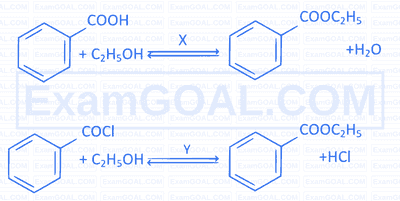Chemistry
At $T(\mathrm{~K})$, the $p, V$ and $u_{\mathrm{rms}}$ of 1 mole of an ideal gas were measured. The following graph is obtained. What is it slope ( $m$ )?
( $x$-axis $=p V: y$-axis $u_{\mathrm{rms}}^2, M=$ Molar mass $)$

A flask contains 98 mg of $\mathrm{H}_2 \mathrm{SO}_4$. If $3.01 \times 10^{20}$ molecules of $\mathrm{H}_2 \mathrm{SO}_4$ are removed from the flask. The number of moles of $\mathrm{H}_2 \mathrm{SO}_4$ remained in flask is
$$ \left(N_A=6.02 \times 10^{23}\right) $$
The solubility of barium phosphate of molar mass ' $M$ ' $\mathrm{g} \mathrm{mol}^{-1}$ in water is $x \mathrm{~g}$ per 100 mL at 298 K . Its solubility product is $1.08 \times\left(\frac{x}{M}\right)^a \times(10)^b$. The values of $a$ and $b$ respectively are
Consider the following standard electrode potentials ( $E^{\circ}$ in volts) in aqueous solution.
$$ \begin{array}{|c|c|c|} \hline \text { Element } & M^{3+} / M & M^{+} / M \\ \hline \mathrm{Al} & -1.66 & +0.55 \\ \hline \mathrm{TI} & +1.26 & -0.34 \\ \hline \end{array} $$
Based on this data. which of the following statements is correct?

The following graph is obtained for vapour pressure (in atm) (on $Y$-axis) and $T$ (in K) (on $X$-axis) for aqueous urea solution and water. What is the boiling point (in K) of urea solution?
(Atmospheric pressure $=1 \mathrm{~atm}$ )

Given below are two statements.
Statement I : Liquids $A$ and $B$ form a non-ideal solution with negative deviation. The interactions between $A$ and $B$ are weaker than $A-A$ and $B-B$ interactions.
Statement II : In reverse osmosis, the applied pressure must be higher than the osmotic pressure of solution
The correct answer is
The standard reduction potentials of $2 \mathrm{H}^{+} / \mathrm{H}_2, \mathrm{Cu}^{2+} / \mathrm{Cu}, \mathrm{Zn}^{2+} / \mathrm{Zn}$ and $\mathrm{NO}_3^{-}, \mathrm{H}^{-} / \mathrm{NO}$ are 0.0 0.34 . -0.76 and 0.97 V respectively. Identify the correct statements from the following.
I. $\mathrm{H}^{+}$does not oxidise Cu to $\mathrm{Cu}^{2+}$
II. Zn reduces $\mathrm{Cu}^{2+}$ to Cu
III. $\mathrm{NO}_3^{-}$oxidises Cu to $\mathrm{Cu}^{2+}$
$$ \text { Match List - I, with List-II. } $$
$$ \begin{array}{llll} \hline & \text { List I } & & \text { List II } \\ \hline \text { I } & \text { Colloidal antimony } & \text { A } & \text { Kalaazar } \\ \hline \text { II } & \text { Silver sol } & \text { B } & \text { Intermuscular injection } \\ \hline \text { III } & \text { Milk of magnesia } & \text { C } & \text { Eye lotion } \\ \hline \text { IV } & \text { Gold sol } & \text { D } & \text { Stomach disorder } \\ \hline \end{array} $$
$\mathrm{P}_2 \mathrm{O}_3+\mathrm{H}_2 \mathrm{O} \rightarrow X$, Red $\mathrm{P}_4+$ alkali $\rightarrow Y$
$X, Y$ are oxoacids of phosphorous. The number of $\mathrm{P}-\mathrm{OH}$ bonds in $X, Y$ respectively is
$$ \mathrm{P}_2 \mathrm{O}_3+\mathrm{H}_2 \mathrm{O} \rightarrow X $$
Given below are two statements.
I. Cytosine and guanine are formed in equal quantities in DNA hydrolysis.
II. Adenine and uracil are formed in equal quantities in RNA hydrolysis.
The correct answer is
$$ \text { Identify the correctly matched pair from the following. } $$

Hydrolysis of an alkyl bromide $\left(\mathrm{C}_5 \mathrm{H}_{11} \mathrm{Br}\right)$ follows first order kinetics. Reaction of $X$ with Mg in dry ether followed by treatment of $\mathrm{D}_2 \mathrm{O}$ gave $Y$, What is $Y$ ?
Which of the following sets of reagents convert toluene to benzaldehyde?
A. $\mathrm{Cl}_2 \mid h v ; \mathrm{H}_2 \mathrm{O}, \Delta$
B. $\mathrm{KMnO}_4 \mid \mathrm{OH}^{-} ; \mathrm{H}^{+}$
C. $\mathrm{Cl}_2 \mid \mathrm{Fe} ; \mathrm{H}_2 \mathrm{O}$
D. $\mathrm{CrO}_2 \mathrm{Cl}_{21} \mid \mathrm{CS}_2 ; \mathrm{H}_3 \mathrm{O}^{+}$
What are $X$ and $Y$ respectively in the following reactions?

$$ \text { IUPAC names of the following compounds } A \text { and } B $$ are

Mathematics
Assertion (A) : If $B$ is a $3 \times 3$ matrix and $|B|=6$, then $|\operatorname{adj}(B)|=36$
Reason (R) : If $B$ is a square matrix of order $n$, then $|\operatorname{adj}(B)|=|B|^n$
Assertion (A) : If $A=10^{\circ}, B=16^{\circ}$ and $C=19^{\circ}$, then $\tan 2 A \tan 2 B+\tan 2 B \tan 2 C+\tan 2 C \tan 2 A=1$
Reason (R) : If $A+B+C=180^{\circ}, \cot \frac{A}{2}+\cot \frac{B}{2}+\cot \frac{C}{2}$
$$ =\cot \frac{A}{2} \cot \frac{B}{2} \cot \frac{C}{2} $$
Which of the following is correct ?
The coefficient of variation for the frequency distribution is
$$ \begin{array}{|c|l|l|l|} \hline \boldsymbol{x}_{\boldsymbol{i}} & 4 & 3 & 1 \\ \hline \boldsymbol{f}_{\boldsymbol{i}} & 1 & 3 & 5 \\ \hline \end{array} $$
$$ \int_{-1}^1\left(\sqrt{1+x+x^2}-\sqrt{1-x+x^2}\right) d x= $$
$\frac{d y}{d x}=\frac{y+x \tan \frac{y}{x}}{x} \Rightarrow \sin \frac{y}{x}=$
Physics
The acceleration of a particle which moves along the positive $X$-axis varies with its position as shown in the figure. If the velocity of the particle is $0.8 \mathrm{~ms}^{-1}$ at $x=0$ , then its velocity at $x=1.4 \mathrm{~m}$ is $\left(\right.$ in $\left.\mathrm{ms}^{-1}\right)$

A person climbs up a conveyor belt with a constant acceleration. The speed of the belt is $\sqrt{\frac{g h}{6}}$ and coefficient of friction is $\frac{5}{3 \sqrt{3}}$. The time taken by the person to reach from $A$ to $B$ with maximum possible acceleration is

In a spring block system as shown in figure. If the spring constant $k=9 \pi^2 \mathrm{Nm}^{-1}$, then the time period of oscillation is

Match the following ( $f$ is number of degrees of freedom)
$$ \begin{array}{llll} \hline& \text { Gases } & & \frac{C_p}{C_v} \text { value } \\ \hline \text { A } & \text { Monoatomic } & \text { I } & \frac{4+f}{3+f} \\ \hline \text { B } & \text { Diatomic (rigid) } & \text { II } & \frac{5}{3} \\ \hline \text { C } & \text { Diatomic (non-rigid) } & \text { III } & \frac{7}{5} \\ \hline \text { D } & \text { Polyatomic } & \text { IV } & \frac{9}{7} \\ \hline \end{array} $$